
|
Sale 46
The Millennia Collection
| Lot |
Photo |
Description |
Realized |
Lot 670 |
 |
German States -- Regensburg. Taler, 1791. Dav-2630; Beckb-7118; KM-465. Mintmaster, Georg Christoph Busch. City view. Reverse: Bust of Leopold II right. Fully lustrous with reflective surfaces and lovely mauve and blue iridescent toning. NGC graded MS-62 Prooflike.
Leopold was the younger brother of Joseph II. As insufferable as his brother was, he was conciliatory and reasonable. His early death after just two years as Emperor rendered his rule inconsequential. Had he lived longer, possibly he would have reached an accord with revolutionary France and his sister, Marie Antionette.
Estimated Value $800 - 900.
Ex Irving Goodman Collection.
View details and enlarged photos
| Realized
$1,438 |
Lot 671 |
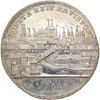 |
German States -- Regensburg. Taler, 1793. Dav-2633; Beckb-7120; KM-469. Mintmaster, Georg Christoph Busch. City view. Reverse: Bust of Francis II right. Full mint brilliance with lovely steel-gray and iridescent blue toning. A lovely example of a mint state city view taler. NGC graded MS-64 Prooflike.
Franz was the last of the Holy Roman Emperors. After being defeated by Napoleon at the Battle of Austerlitz in 1806, he dissolved the empire and formed the Empire of Austria. He was a major opponent of Revolutionary France, and seemed always to lose battles to Napoleon.
Estimated Value $1,500 - 2,000.
Ex Irving Goodman Collection.
View details and enlarged photos
| Realized
$2,990 |
Lot 672 |
 |
German States -- Reuss-Ebersdorf. Species Thaler, 1812-L. Dav-804; Th-282; J-98; KM-32. Heinrich LI, 1779-1822. Crowned and mantled shield. Reverse: Value, date and "L" on reverse for George Christoph Lowel, engraver in Saalfeld. Only 1,575 pieces minted. Prooflike fields with gray and olive green toning. Rare. NGC graded MS-61 Prooflike.
The rulers of Reuss were originally known as the Lords of Weida, but when one married a Russian princess the male offspring became known as "Der Russe" and later the name Reuss just stuck. Every one of the male members of the family was named Heinrich. This would be a terrible burden at family gatherings.
Estimated Value $1,500 - 1,750.
Ex Irving Goodman Collection.
View details and enlarged photos
| Realized
$2,128 |
Lot 673 |
 |
German States -- Reuss-Obergreiz. Taler, 1769. Dav-2634; KM-67. Henry XI, 1768-1800. Head right. Reverse: Helmeted arms dividing date. Minor surface stress marks. Beautiful iridescent toning and fully lustrous. NGC graded MS-64 Prooflike.
Estimated Value $1,500 - 1,750.
Ex Irving Goodman Collection.
View details and enlarged photos
| Realized
$2,645 |
Lot 674 |
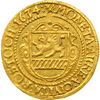 |
Rostock. Ducat, 1634. Fr-2587. 3.47 grams. 22.21 mm. In the name of Ferdinand II, 1618-1637. Obv. Arms. Griffin within elaborate cartouche within inner circle. Leg: MONETA.AUREA.CIVITA:ROSTOCH: 1634. Reverse Double headed eagle within inner circle, crown above. Leg: FERDINANDUS .II.D:G:ROM:IMP:S:AUG: NGC graded MS-63.
Rostock, located on an estuary by the Baltic Sea, was an important Hanseatic city and port of the period. Although technically under rule of Mecklenburg, the city was effectively independent and began issuing coins as early as 1325. Many coins were produced, but most were used in trade, so almost none have been preserved. To find one of these in this superb quality is most unusual.
Estimated Value $2,500 - 3,000.
(*).
View details and enlarged photos
| Unsold |
Lot 675 |
 |
German States -- Saxony. Guldengroschen, ND (1512), Hall. Dav-9699; Schnee-37; Schulten-3019; Coll. Merseburger-417; Coll. Vogel-5935. 28.76 grams. Friedrich III, the Wise, 1486-1525. Bust of bearded Friedrich right, cuirassed and wearing embroidered cap, with raised shields quartering the inscription; FRID' DVX SAX - ELECT ' IMPER. QVE LOCVM : TEN - E'S. GENERA'; inscription on his breastplate: IHS : MARIA, = "Jesus; Mary." Reverse: Nimbate eagle, with shield on breast bearing arms of Austria and Burgundy; MAXIMILIANVS ROMANORVM REX SEMPER AVGVST. Lustrous bold relief devices on reflective fields. Fine medium gray old-collection toning, with russet to iridescent gold-green undertones. Faint old inventory number inked on left obverse field. Rare, and very much more so in this grade. One of the finest known. NGC graded MS-62.
Friedrich the Wise is probably best known for his support of Martin Luther. Interestingly enough, his support centered around his ideas of justice, not religion. He never even understood completely Luther's beliefs. He just wanted to insure Luther got a fair trail. Ironically, Friedrich, who was a devout Catholic, inadvertantly furthered the cause of Protestantism in Germany more than almost anyone else.
Estimated Value $10,000 - 12,500.
Ex Virgil Brand Collection, Zurich 1997, lot 5020.
View details and enlarged photos
| Realized
$16,675 |
Lot 676 |
 |
German States -- Saxony. Guldengroschen (28.76 g), ND (1512), Hall. Dav-9699; Schnee-37; Schulten-3019; Coll. Merseburger-417; Coll. Vogel-5935 (this coin). 28.76 grams. Friedrich III, the Wise, 1486-1525. Bust of bearded Friedrich right, cuirassed and wearing embroidered cap, with raised shields quartering the inscription; FRID' DVX SAX - ELECT ' IMPER. QVE LOCVM : TEN - E'S. GENERA'; inscription on his breastplate: IHS : MARIA, = "Jesus; Mary." Reverse: Nimbate eagle, with shield on breast bearing arms of Austria and Burgundy; MAXIMILIANVS ROMANORVM REX SEMPER AVGVST. Lustrous bold relief devices on reflective fields. Minor striking flaw on eagle, and negligible flan split, otherwise a choice strike with especially attractive and sympathetic portrait. Fine old artistic toning. Rare -- more so in this grade. NGC graded MS-63.
Friedrich, who was a great proponent of education, founded the University of Wittenberg in 1502 in the city of Wittenberg, where Martin Luther nailed his 95 Theses on the church doors. This sparked the beginning of the Protestant Reformation.
This masterful coin portrait, in bold relief and medallic in appearance, derives from a sculptural likeness fashioned by the famous German artist Lucas Cranach the Elder. The coin's dies were cut by Ulrich Ursenthaler of Hall, in Tyrol. Among Cranach's portrait paintings are several of Martin Luther, also residing in Wittenberg and under the Elector's protection. Cranach even performed as go-between in broaching Martin Luther's proposal of marriage to the former nun Katharina von Bora. Cranach and his wife were later witnesses at Luther's and Katharina's wedding, and he would also be godfather to their first son.
Estimated Value $10,000 - 12,500.
Ex Schultess-Rechberg Collection, auctioned by J. & A. Erbstein, in June 1869, lot 4408 (with original description ticket); Ex R. Vogel Collection, no. 5935; Illustrated in Money of The World, coin 92.
View details and enlarged photos
| Realized
$19,550 |
Lot 677 |
 |
German States -- Saxony. Taler, 1552. Dav-9787; Schnee-690; Schulten-3245. Moritz, 1541-1553. Albertine line. Annaberg mint. Mintmaster, Matthaus Rothe. Armored half figure right, holding sword upright. Reverse: Shield of arms, date above. Lustrous with light golden toning. As struck. NGC graded MS-62.
A range of mountains, the Erzgebirge, literally the "ore mountains," occupies the old border between Saxony, of modern Germany, and Bohemia, in what is now Czechoslovakia, where, among the holdings of a Count Schlik, silver was discovered around 1512-16. Rather than sell off the silver, he chose to mint it. From this modest beginning emerged a coinage denomination that would impact the monetary history of the modern world more than any other -- for it was the origin of our "dollar."
Estimated Value $800 - 900.
Ex Irving Goodman Collection.
View details and enlarged photos
| Realized
$949 |
Lot 678 |
 |
German States -- Saxony. Taler, 1554. Dav-9791; Mersb-649 var; Schnee-703. August, 1553-1586. Annaberg mint. Mintmaster, Leupold Holzxchucher. Capped bust right holding sword over shoulder. Reverse: Helmeted arms. Some luster with handsome old silvery toning. Virtually as struck. NGC graded AU-55.
Estimated Value $400 - 500.
Ex Irving Goodman Collection.
View details and enlarged photos
| Realized
$690 |
Lot 679 |
 |
German States -- Saxony. Taler, 1582 (Dresden). Dav-9798. August. Half figure in armor leaning slightly to right holding sword. Reverse: Helmeted arms. Beautifully toned in shades of iridescent gold. NGC graded MS-62.
Estimated Value $400 - 500.
Ex Irving Goodman Collection.
View details and enlarged photos
| Realized
$661 |
Lot 680 |
 |
Saxony. Ducat, 1617. Fr-2663; KM-109; Merb-877. 3.44 grams 25.16 mm. Johann Georg I, 1611-1656. Struck to commemorate the Centennial of the Reformation. Obv. Johann George with sword over right shoulder facing right, shield below. Leg: VERBVMDNIMANETINAETERNM. Reverse Friedrich III with sword over right shoulder facing right., shield below. Leg: SECVLVM - LVTHERNANVM. NGC graded MS-62.
One hundred years earlier, Martin Luther nailed his 95 theses to the Wittenberg door, effectively beginning the Protestant Reformation. Of course, there were anti-church reformers earlier, but Luther had the most influence, especially in central Europe.
Estimated Value $1,500 - 2,000.
(*).
View details and enlarged photos
| Realized
$2,530 |
Lot 681 |
 |
German States -- Saxony. Taler, 1629. Dav-7601. Johann Georg. Armored bust leaning to right holding sword. Reverse: Intricate helmeted arms. Toned in beautiful shades of iridescent golden blue. NGC graded MS-64.
Estimated Value $600 - 700.
Ex Irving Goodman Collection.
View details and enlarged photos
| Realized
$2,070 |
Lot 682 |
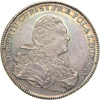 |
German States -- Saxony. Taler, 1763-JfoF. Dav-2677B; Mersb-1892; Schnee-1052. Friedrich Christian, October 5th to December 12, 1763. Leipzig mint. Mintmaster, Johann Friedrich o Feral and Johann Friedrich Stieler. Bust right with "S" on arm. Reverse: Crowned shield with initials. Beautifully toned iridescent silvery blue. NGC graded AU-58.
Friedrich Christian ruled just a bit over two months.
Estimated Value $400 - 500.
Ex Irving Goodman Collection.
View details and enlarged photos
| Realized
$1,150 |
Lot 683 |
 |
German States -- Saxony. Taler, 1806. Dav-850; Th.289; Mersb-1998; Cr-135. Friedrich August. Lovely silvery lilac iridescent toning with full original luster. NGC graded MS-64.
Estimated Value $400 - 500.
Ex Irving Goodman Collection.
View details and enlarged photos
| Realized
$504 |
Lot 684 |
 |
German States -- Saxony. Ducat, 1818-IGS (Dresden). Fr-2884; KM-1073. 3.48 grams. Friedrich August III, as Friedrich August I, 1806-1827. Head right. Reverse: Crowned oval shield with crossed branches around, dividing date; initials below. Sharply struck. Semi-matte devices on mirror fields. Choice example. NGC graded MS-64 Prooflike.
Friedrich August became the first king of Saxony in 1806. While he and the other German states were losing to Napoleon, he reasoned it was better to ally himself with the French than to continue to lose. This worked until Napoleon lost at the Battle of Leipzig in 1813. This caused his imprisoment by the allies and his loss of half his territory. This indirectly led to the dominance of Prussia in the 19th century.
Estimated Value $2,000 - 2,500.
View details and enlarged photos
| Realized
$3,335 |
Lot 685 |
 |
German States -- Saxe-Altenburg. 2 Taler, 1843-G. Dav-811; Th-353; J-108; Cr-10. Joseph, 1834-1848. Dresden mint. Mintmaster, Johann Georg Grohmann. Head left. Reverse: Crowned mantled arms. Fully lustrous with lovely shades of russet, gold and green iridescent toning. Mintage of only 4,700 double talers this year, few of which have survived in this outstanding condition. Here is an elegant and fully original example. NGC graded MS-63.
Estimated Value $2,000 - 2,500.
Ex Irving Goodman Collection.
View details and enlarged photos
| Realized
$2,415 |
Lot 686 |
 |
German States -- Saxe-Altenburg. 2 Taler, 1852-F. Dav-813; Th-355; J-112; Cr-13. Georg, 1848-1853. Dresden mint. Mintmaster, Gustav Theodor Fischer. Head right. Reverse: Crowned mantled arms. Beautifully toned in shades of olive green, blue and russet. One-year type, rare this nice. NGC graded MS-64.
Georg produced no single Talers and only this one Double Taler in 1852, a very important coin for the type collector with a low mintage (9,400), and one of the finest known. Twenty years later, the coinage of Germany would change and the smaller 5 Mark would become the largest silver coin being produced.
Estimated Value $2,000 - 2,500.
View details and enlarged photos
| Realized
$4,370 |
Lot 687 |
 |
German States -- Saxe-Coburg-Gotha. 2 Taler, 1841-G. Dav-819; Th-342; J-273; Cr-107. Ernst I, 1826-1844. Dresden mint. Mintmaster, Johann Georg Grohmann. Head left. Reverse: Crowned and mantled arms. Lovely deep lilac and silvery gray toning and fully lustrous. Rare grade. NGC graded MS-63.
Ernst was the father of Albert, husband of Queen Victoria of Great Britain. Thus the British royal family was of the Saxe-Coburg-Gotha line. The name was changed to the House of Windsor during the rule of George V, to disassociate the family from their German enemy in World War I.
Estimated Value $2,000 - 2,500.
Ex Irving Goodman Collection.
View details and enlarged photos
| Realized
$3,450 |
Lot 688 |
 |
Saxe-Ernestine Line. Goldgulden, ND. Fr-2930. 3.24 grams. 23.80 mm. Leipzig Mint. Mintmaster Ulrich Gebhart, 1518-1532. Friedrich III (The Wise), Johann and Georg, 1500-1507. Obv. Haloed St. John with haloed lamb in left hand, pointing to it and right hand under, Saxon and Elector's arms. Leg: FRI.IO.GE.D.G.DV. SAX. Reverse Orb within beaded circle. Leg: +MONETA.NOVA.AUREA.LIPES. Rare. NGC graded AU-50.
Saxony divided in 1485 into the Ernestine and Albertine lines. The two grandsons of Friedrich, Ernst and Albert headed the two divisions. The Ernestine line lated only until 1547, and all its gold coins are rare.
Estimated Value $3,000 - 4,000.
(*).
View details and enlarged photos
| Unsold |
Lot 689 |
 |
German States -- Saxe-Gotha-Altenburg. Taler, 1776. Dav-2725; Mersb-3280; Schnee-533; Cr-40. Ernst II Ludwig, 1772-1804. Mintmaster, Theodor Stockman. Head right with crane below. Reverse: Crowned arms in sprays with divided date above. Beautifully toned in shades of olive green, yellow, russet and blue. NGC graded MS-63.
Despite the many conventions held to sort out German monetary confusion, unity was only achieved in 1871 by the creation of the German Empire. During the early part of the 19th century, the number of states and free cities issuing coins was much reduced. After the Napoleonic era, in 1815, the number was down to about 30. By 1871 this number was further reduced to about a dozen, with Prussia having absorbed most of them. Here is not only a beautiful coin but also one that should be of particular interest to American collectors, for its date.
Estimated Value $1,500 - 2,000.
Ex Irving Goodman Collection.
View details and enlarged photos
| Realized
$1,725 |
Lot 690 |
 |
German States -- Saxe-Weimar. Taler, 1658. Dav-7547. Wilhelm IV, 1640-1662. Date on reverse in chronogram, on the new castle Wilhelmsburg. Facing bust. Reverse: Castle shown from its courtyard. Well struck with a trace of original luster and lovely old toning. NGC graded MS-63.
When this coin was minted, the Thirty Years War had concluded, and its devestation was just being repaired. It was a time to rebuild and to improve defenses. Wilhelmsburg Castle was an example of great pride to the duke, and this rare commemorative coin indicates the importance of its completion.
Estimated Value $3,000 - 3,500.
View details and enlarged photos
| Realized
$5,750 |
Lot 691 |
 |
German States -- Saxe-Weimar-Eisenach. Taler, 1764-K-FS. Dav-2759; Mersb-3988; Schnee-396; Cr-50a. Anna Amalia, 1758-1775, Son Karl August. Eisenach mint. Mintmaster, Friedrich Schaffer of Mannheim. Bust left with "K" below. Reverse: Crowned arms. Lustrous with lovely iridescent toning. NGC graded MS-63.
Anna Amalia was a talented woman of the 18th century who not only served as regent of the duchy for seventeen years in a most able fashion but was also an important patron of the arts, and a notable composer in her own right, who had the likes of Goethe and Schiller visiting Weimar on a regular basis.
Estimated Value $1,500 - 2,000.
Ex Irving Goodman Collection.
View details and enlarged photos
| Realized
$2,185 |
Lot 692 |
 |
German States -- Saxe-Weimar-Eisenach. 2 Taler, 1840-A. Dav-844; Th-383; J-532; Cr-88. Carl Friedrich, 1828-1853. Berlin mint. Head left. Reverse: Crowned arms. Reflective fields with gorgeous iridescent silvery gold toning. NGC graded MS-63.
The Duchy was founded in 1644, and its status was raised to that of a Grand Duchy in 1814. Coins made in quantity, in all sizes and metals, began around the mid-18th century, including trade ducats. The above 2 Taler was the largest circulating silver issue of the 19th century, with the last being struck in 1855.
Estimated Value $900 - 1,100.
Ex Irving Goodman Collection.
View details and enlarged photos
| Realized
$1,668 |
Lot 693 |
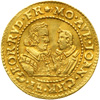 |
Silesia-Liegnitz-Brieg. Ducat, 1609. Fr-3145 variant. 3.47 grams. 22.38 mm. Johann Christian and Georg Rudolf, 1602-1621. Obv. There appears to be a second figure in the initial mark of the legend. Double portrait facing each other. Leg:*+MO.AVR.IOAN.CHR.ET.GEOR.RVD.FR. Reverse Crowned quartered arms within beaded circle. Leg: DVC.SIL.LIG.ET.BREG.1607. Rare. NGC graded MS-62.
Estimated Value $3,000 - 3,500.
(*).
View details and enlarged photos
| Realized
$6,325 |
Lot 694 |
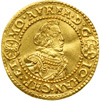 |
Silesia-Liegnitz-Brieg. Ducat, 1610. Fr-3166. 3.46 grams. 22.29 mm. Johann Christian and Georg Rudolf, 1602-1621. Obv. Bust to right between two arms within beaded circle. Leg: (shield) MO.AVREA.D:G (shield) IOHAN.CHR.ET. Reverse Bust facing left with arms at sides and date in the field on either side of bust. Leg: (shield) GEOR .RVD.FR.D (shield) SI.LIG.ET.BREG. NGC graded AU-58.
Instead of conjioned portraits, we find here one duke on each side of the coin. Very scarce and of exceptional quality.
Estimated Value $3,000 - 3,500.
(*).
View details and enlarged photos
| Realized
$5,520 |
Lot 695 |
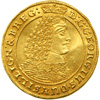 |
Silesia-Liegnitz-Brieg. Ducat, 1660. Fr-3202; Saurma-Jeltsch-Pl XXII,#137 (silver). 3.45 grams. 22.17 mm. Georg III, 1639-1664. Obv. Crown above portriat right within beaded circle. Leg: D:G.GEORGIUS.DUX. SIL.LIGN. & BREG: Reverse Arms with three helmets within beaded circle. Leg: SORS.MEA ADO - MINO AN:1660. Rare. NGC graded MS-61.
Georg was technically the duke of Brieg but not Liegnitz. That did not stop him from claiming title to both duchies on the coin. An exceptional example of this rare type.
Estimated Value $4,000 - 5,000.
(*).
View details and enlarged photos
| Realized
$8,338 |
Lot 696 |
 |
German States -- Silesia-Liegnitz-Brieg. Taler, 1661. Dav-7740; F-S-1903. Christian of Wohlau, 1639-1673. Crown over bust right. Reverse: Helmeted arms with "E W" (for Wardein Elias Weiss) below. Struck evenly on a broad flan, with great detail in the portrait which features a tiny crown upon the boldly engraved portrait. Elegant multi-hued silvery greenish gray toning. Rare. NGC graded MS-62.
Estimated Value $1,500 - 2,000.
Ex Irving Goodman Collection.
View details and enlarged photos
| Realized
$5,750 |
Lot 697 |
 |
German States -- Stolberg. Taler, 1649. Dav-7786; Slg.Frieder-668. Johann Martin, 1638-1669. Orb, stag left against a pillar. Reverse: Helmeted arms. Sharply struck with considerable original mint luster and fabulous blue iridescent toning. Very rare in this condition. NGC graded MS-63.
This county, located in the mineral-rich Harz Mountains of central Germany, is said to have been founded by a 6th-century Italian nobleman, Otto Colonna, and in obeisance to the founder a column (colonna) is regularly incorporated into the clan's emblem seen on these coins.
Estimated Value $1,500 - 2,000.
Ex Irving Goodman Collection.
View details and enlarged photos
| Realized
$2,990 |
Lot 698 |
 |
German States -- Stolberg-Wernigerode. Ducat, 1818. Fr-3363; Cr-25. Christian Friedrich, 1778-1824. Stag left. Reverse: Value and date in wreath. Struck to commemorate the golden wedding anniversary. Flan slightly wavy, light contact marks and scuff as illustrated, but sharply struck and highly lustrous. Rare. NGC graded MS-62 Prooflike.
Stolberg-Wernigerode is the second main branch of the Stolberg line. A formal division of lands between the Stolberg-Stolberg and Wernigerode branches occurred in 1645, but it is only the Wernigerode line that continued to strike coins after 1800. Their trade coin, the gold Ducat, was struck in single denomination size only, and then very sporadically from 1661 to 1824. The above coin is typical of its type, although this is more of a commemorative piece, with only 308 examples struck.
Estimated Value $1,500 - 2,000.
View details and enlarged photos
| Realized
$2,185 |
Lot 699 |
 |
Teutonic Order. Ducat, ND. Fr-3379. 3.46 grams. 21.73 mm. Maximilian of Austria, 1590-1618. Obv. Archduke standing right; left hand on sword hilt and right hand on scepter. Leg: MAX:D:G:AR:AV - D:B:MA:PR.ADM Reverse Crowned complex arms on shield. Leg: Orb+ ETOR:TEV:P:GER:ITA:MAG:CO:HA:ET:T A lovely well struck, mint fresh coin. NGC graded MS-63.
Maximilian was both Emperor of the Holy Roman Empire and Grandmaster of the Teutonic Order. The Teutonic Order was founded during the Crusades to safeguard the Christian pilgrims visiting the Holy Land. It was different from the other orders in that it was almost exclusively German. Already in the 16th century the order was in decline. Yet it still produced great coins.
Estimated Value $4,000 - 5,000.
(*).
View details and enlarged photos
| Unsold |
Lot 700 |
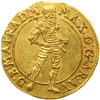 |
Teutonic Order. Ducat, ND. Fr-3379. 3.48 grams. 21.25 mm. Maximilian of Austria, 1590-1618. Obv. Archduke standing right; left hand on sword hilt and right hand on scepter. Leg: MAX:D:G:AR:AV - D:B:MA:PR.ADM Reverse Crowned complex arms on shield. Leg: Orb+ ETOR:TEV:P:GER:ITA:MAG:CO:HA:ET:T. NGC graded AU-58.
Estimated Value $3,000 - 4,000.
(*).
View details and enlarged photos
| Unsold |
Lot 701 |
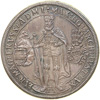 |
German States -- Teutonic Order. Taler, 1603 (Hall). Dav-5848; Dudik-187b. Maximilian of Austria, 1588-1618. Emperor standing. Reverse: Emperor on horseback. Beautifully toned in shades of deep lilac blue and mauve, also sharply impressed on a broad flan, thus truly exceptional. NGC graded MS-65.
The Teutonic Order was a military order of medieval origin, modeled on the Hospitallers of St. John. The origin dates to the Third Crusade, in 1190, under the walls of besieged Accon (Acre) in Palestine, where German pilgrims from Lubeck and Bremen with the Duke of Holstein had set up a temporary hospital (a tent actually) to care for the sick and wounded of their country. After the capture of Acre, the hospital was permanently established in the city with the aid of Frederick of Swabia, leader of the German Crusade. The Order of Teutonic Knights was founded, taking its place with the two other orders of Jerusalem, the Hospitallers and the Templars. The members were nobles and knights who took monastic vows of poverty and chastity. This classic taler captures the emblematic majesty of the order.
Estimated Value $800 - 1,000.
Ex Irving Goodman Collection.
View details and enlarged photos
| Realized
$3,450 |
Lot 702 |
 |
German States -- Teutonic Order. 2 Talers, 1673. Dav-5860. 57.5 grams. Johann Kaspar II von Ampringen, 1664-1684. Bearded and cuirassed bust right. Reverse: Madonna and child, crowned and holding scepter and globus cruciger, above crowned arms with DEO - DVCE separting. Very bold strike for issue, with with some minor doubling -- seen mostly along one axis. Fine original, old gray toning. Handsome portrait. Very rare. NGC graded AU-58.
The Madonna and child motif is found on many different coins. Hungary and Bavaria probably used this design the most. It is indicative of how important the Virgin Mary was in late medieval and Renaissance Catholicism.
Estimated Value $8,000 - 9,000.
View details and enlarged photos
| Realized
$10,925 |
Lot 703 |
 |
German States -- Thuringen. Bracteate / Ritterbrakteat, ND. Cf. Peus Bonhoff Sale 293, lot 1334. 0.49 grams. Hermann I, 1190-1217. The Count fully armored on similarly accoutered horse left, holding spear and triangular shield with blazon; within inscribed (?) double-beaded border. Reverse: Incuse of obverse. A better strike, and remarkably free of the usual creases and crinkles seen on these fragile coins. A few minor edge cracks, with negligible loss at 9 o'clock. Beautiful old iridescent bull's-eye toning -- darkest at edges, lightest at center; the reverse mostly with light toning. (Too large for holder). NGC graded Uncirculated.
The primitive bracteates, with their striking weaknesses, are an excellent indication of the deterioration of the technology of medieval Europe. Here is an exceptional representation of the type.
Estimated Value $500 - 600.
View details and enlarged photos
| Realized
$690 |
Lot 704 |
 |
German States -- Westphalia. Proof 20 Franken, 1808-J (Paris). Fr-3517; Schl.-893; J-39a; C-33. 6.44 grams. Jerome Napoleon Bonaparte, 1807-1813. Laureate bust left. Reverse: Value within wreath; horse-head symbol. Plain edge. Fully struck, some faint scattered hairlines. An exceptional specimen, and very rare. NGC graded Proof 65.
Estimated Value $5,000 - 6,000.
Illustrated in Money of The World, coin 129.
View details and enlarged photos
| Realized
$6,038 |
Lot 705 |
 |
German States -- Westphalia. Taler, 1811-C (Cassel). Dav-933; Cr-20a; Th-413. Jerome Napoleon. Laureate head right. Reverse: Value and date. Considerable original mint luster. NGC graded MS-63.
Estimated Value $600 - 700.
Ex Irving Goodman Collection.
View details and enlarged photos
| Realized
$1,208 |
Lot 706 |
 |
German States -- Westphalia. 10 Taler, 1812-B. Fr-3513; Schl.-883. Jerome Napoleon Bonaparte, 1807-1813. Laureate bust left. Reverse: Value. Faintly toned with reddish hues, a lovely specimen. NGC graded MS-63.
Jerome, the younger brother, was one of the interesting "black sheep" of the Napoleon clan. He began his military career in the navy, and while laying over in America he met and fell in love with and wed an American heiress, Elizabeth Patterson of Baltimore. Napoleon was furious at their marriage and relations between the two brothers soured for some time. In 1806, when made a vice-admiral, Jerome repaired his relationship with Napoleon and joined him as a divisional commander of the Bavarian forces of the Grande Armee. In 1807, he was made King of Westphalia and, after divorcing his American wife, married a Wurttemburg princess. The first marriage produced a child, also named Jerome Napoleon.
Estimated Value $2,500 - 3,000.
View details and enlarged photos
| Realized
$4,830 |
Lot 707 |
 |
German States -- Würzburg. Taler, 1728. Dav-2886; Helm-599; Pil-1134; KM-283. Christoph Franz von Hutten, 1724-1729. Bust right. Reverse: Helmeted arms with divided date below. Imaginatively engraved in elegant style. Reflective fields with lovely old gray toning. Rare. NGC graded MS-64.
This important bishopric, located in Franconia, obtained minting rights in the 11th century. Their coining was of long duration, extensive and varied. Apparently the 2 Talers were the largest of their silver, and seldom struck.
Estimated Value $1,500 - 1,750.
Ex Irving Goodman Collection.
View details and enlarged photos
| Realized
$2,875 |
Lot 708 |
 |
German States -- Würzburg. Ducat, 1777. Fr-3725; KM-409. Adam Friedrich. Bust in square. Reverse: Madonna in square. Deeply engraved and sharply struck, with reflective fields offset by the beautiful central engraving and the high rims. A classic image in nearly pure gold of the late 18th century. NGC graded MS-63.
Estimated Value $800 - 900.
View details and enlarged photos
| Realized
$1,610 |
|
|